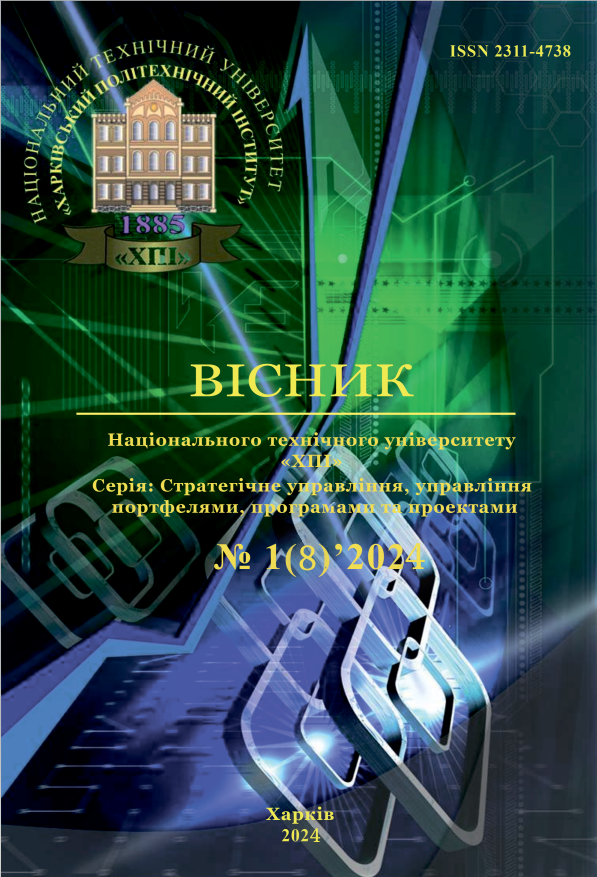RESEARCH OF THE MANAGEMENT OF SOFTWARE SYSTEM DEPLOYMENT USING THE RESOURCES OF CLOUD PROVIDERS
DOI:
https://doi.org/10.20998/2413-3000.2024.8.7Keywords:
deployment management, software system, data center, cloud providers, Build, DeployAbstract
The main stages of the process of deploying a software system using the resources of cloud providers are analyzed. The models of possible options for managing the deployment of a software system using the BPMN notation are developed. Based on the modeling, the advantages and disadvantages of non-automated, automated, and automatic management of the deployment process are identified. A model of automatic deployment of a software system using the resources of cloud providers' data centers in IDEF0 notation has been developed and decomposed, which allowed to study the functional interaction of individual stages of the software system deployment process. Based on the developed contextual and decomposition IDEF0 diagrams, within the framework of modeling the software system deployment process, an analysis of the functional interaction of the Build and Deploy stages was carried out, which showed that these stages have the greatest functional load and require more detailed research in order to find ways to optimize them. With this purpose, were developed and analyzed IDEF0 and DFD decomposition diagrams that model the functional interaction and data flows between the components of the Build and Deploy subprocesses. Analysis of the functional interaction and data flows generated and transferred between the individual components of the Build and Deploy subprocesses revealed an important aspect, which is that each time the source code is compiled, and the container is created, data must be loaded from external libraries. This, in turn, leads to a significant increase in external traffic, which affects the speed of deployment of software systems using the resources of cloud providers' data centers. As a possible way to optimize the Build and Deploy subprocesses, was proposed to create a cache to save the downloaded data from external libraries for reuse, as well as implement control over queries to external libraries and the data caching process, which will minimize the time spent on transferring data from external libraries during automatic deployment.
References
Chandrasekara, C. Beginning Build and Release Management with TFS 2017 and VSTS., 2017, Available at: http://dx.doi.org/10.1007/978-1-4842-2811-1.
Fowler, M. and Beck, K. Continuous Integration: Improving Software Quality and Reducing Risk., Pearson Education, Boston, US. 2006.
Humble, J. and Farley, D. Continuous Delivery: Reliable Software Releases through Build, Test, and Deployment Automation. Pearson Education, Boston, US. 2010.
Coupaye, T. and Estublier, J. Foundations of enterprise software deployment, 2000, Available at: https://doi.org/10.1109/CSMR.2000.827313.
National Institute for the Software Industry (NISI) Continuous Delivery 3.0 Maturity Model (CD3M), 2019, Available at: https://nisi.nl/continuousdelivery/articles/maturity-model.
Grandhi, M. Optimizing Your Modernization Journey with AWS. Packt Publishing, Birminham, UK. 2023.
Vaughan, D. Cloud Native Development with Google Cloud: Building Applications at Speed and Scale, 2023, Available at: https://www.oreilly.com/catalog/errata.csp?isbn=0636920829249.
Rawat, S. CI CD Pipeline with Docker and Jenkins, BPB Online, London, UK. 2023.
Saini, K. Build Process, 2022, Available at: https://iq.opengenus.org/build-process/.
Gurung G. Cloud Deployment Models: A Comparative Analysis For Optimal Performance, Scalability, And Cost Efficiency. Conference: 6th National Conference NATCOM (AICGPT-2023), 2023, Available at: https://www.researchgate.net/publication/374447308_Cloud_Deployment_Models_A_Comparative_Analysis_For_Optimal_Performance_Scalability_And_Cost_Efficiency.
Van Merode, H. Continuous Integration (CI) and Continuous Delivery (CD), Leeuwarden, NL. 2023, pp. 1-9. Available at: https://doi.org/10.1007/978-1-4842-9228-02023.
Rani, M. What is software build- All you need to know! 2019 Available at: https://medium.com/webgentle/what-is-the-software-build-all-you-need-to-know-4046b0e674bb.
Shah, Jay & Dubaria, Dushyant. Building Modern Clouds: Using Docker, Kubernetes & Google Cloud Platform. in 2019 IEEE 9th Annual Computing and Communication Workshop and Conference (CCWC), 2019, Available at: https://doi.org/10.1109/ccwc.2019.8666479.
Zhai, H., Wang, J. Automatic deployment system of computer program application based on cloud computing. Int J Syst Assur Eng Manag 12, 2021, pp.731–740. Available at: https://doi.org/10.1007/s13198-021-01068-0.
Mustafa, O., AWS Deployment Strategies. In: A Complete Guide to DevOps with AWS. Apress, Berkeley, CA. 2023 pp 183–196 Available at: https://doi.org/10.1007/978-1-4842-9303-4_5.
Downloads
Published
Issue
Section
License

This work is licensed under a Creative Commons Attribution-NonCommercial-ShareAlike 4.0 International License.
Our journal abides by the Creative Commons copyright rights and permissions for open access journals.
Authors who publish with this journal agree to the following terms:
Authors hold the copyright without restrictions and grant the journal right of first publication with the work simultaneously licensed under a Creative Commons Attribution-NonCommercial-ShareAlike 4.0 International License (CC BY-NC-SA 4.0) that allows others to share the work with an acknowledgement of the work's authorship and initial publication in this journal.
Authors are able to enter into separate, additional contractual arrangements for the non-commercial and non-exclusive distribution of the journal's published version of the work (e.g., post it to an institutional repository or publish it in a book), with an acknowledgement of its initial publication in this journal.
Authors are permitted and encouraged to post their published work online (e.g., in institutional repositories or on their website) as it can lead to productive exchanges, as well as earlier and greater citation of published work.

